|
Tuesday, Oct. 8
- Breakfast: All-American breakfast
- Breakfast: bacon, egg and cheese bagel
- Twin chili cheese dogs
- Smart cuisine: Mediterranean baked tilapia
- Italian lasagna
- Rachel melt
- Chicken BLT ranch salad
- Beef and rice soup
- Chef's choice soup
Wilson Hall Cafe menu
|
|
Wednesday, Oct. 9
Lunch
- Roasted vegetables and goat cheese on herbed focaccia
- Grilled shrimp and wild rice medley
- Lemon almond butter cake
Friday, Oct. 11
Dinner
- Spinach salad with pears, pecans and balsamic vinaigrette
- Rib eye roast with mustard and black pepper
- Potato and sage gratin
- Winter greens with pancetta and mint
- Swedish apple pie
Chez Leon menu
Call x3524 to make your reservation.
|
|
Nobel Prize in physics honors prediction of Higgs boson
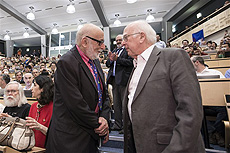 |
Francois Englert and Peter Higgs chat at the July 4, 2012, CERN conference that announced the discovery of the Higgs boson. Photo: CERN
|
Note: For more information on Fermilab's role in the hunt for the Higgs, visit this Web page.
The Swedish Academy announced early this morning that they will award the 2013 Nobel Prize in physics to theorists Peter Higgs and Francois Englert, scientists responsible for developing key concepts in the theory that predicted the Higgs boson.
In the 1960s, the newly minted Nobel laureates each played a part in inventing the concept of the Higgs field, an essential piece of the Standard Model of physics that grants mass to elementary particles. On July 4, 2012, scientists working on experiments at the Large Hadron Collider at CERN announced the discovery of the particle that proves the existence of that field: the Higgs boson. Nearly 2,000 physicists from U.S. institutions participate in the two LHC experiments that made the discovery, CMS and ATLAS. Fermilab serves as the U.S. hub for the CMS experiment.
"It is an honor that the Nobel Committee recognizes these theorists for their role in predicting what is one of the biggest discoveries in particle physics in the last few decades," said Fermilab Director Nigel Lockyer. "I congratulate the whole particle physics community for this achievement."
It took decades of effort by thousands of scientists — including those on experiments at the Large Electron-Positron Collider at CERN, at the Tevatron particle collider at Fermi National Accelerator Laboratory and at the LHC — to find the famous boson. In July 2012 scientists at the Tevatron saw signs of the Higgs boson in independent searches complementary to those performed at the LHC. Today's Nobel announcement underscores the importance of that discovery, one of the most significant in the history of particle physics.
—Kathryn Jepsen
|
Ten things you may not know about the Higgs boson
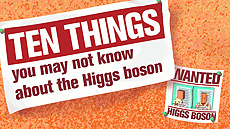 |
Symmetry looks at little-known facts about the Higgs particle. Image: Sandbox Studio
|
1. Peter Higgs' best-known paper on the new particle was initially rejected.
But this was a blessing in disguise, since it led Higgs to add a paragraph introducing the now-famous Higgs particle. In 1964, Higgs wrote two papers, each just two pages long, on what is now known as the Higgs field. The journal Physics Letters accepted the first but sent the second back. Yoichiro Nambu, a highly regarded physicist who had reviewed the second paper, suggested Higgs add a section explaining his theory's physical implications. Higgs added a paragraph predicting that an excitation of the field, like a wave in the ocean, would yield a new particle. He then submitted the revised paper to the competing journal Physical Review Letters, which published it.
Read more
—Kathryn Jepsen
|
This hawk obeys traffic signs
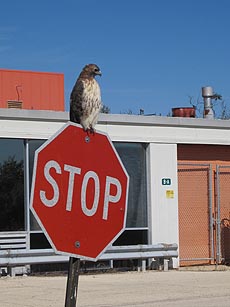 |
| A hawk makes a rest stop on a Fermilab stop sign. Photo: Eric Mieland, ESH&Q |
|
Peter Higgs, Francois Englert win Nobel Prize in physics
From The Washington Post, Oct. 8, 2013
Peter Higgs, check your email! The Nobel Prize folks have something to tell you.
Higgs, the 84-year-old English theorist, was awarded the Nobel Prize in physics on Tuesday along with Francois Englert, of Belgium. They were honored for their work developing the ideas that led to the epic quest to find a tiny particle known as the Higgs boson. Last year, scientists said they'd found it after smashing together beams of particles at CERN, the particle physics laboratory in Geneva.
Englert, 80, materialized by voice Tuesday morning in a teleconference after the announcement in Stockholm. But a Nobel committee official said no one had been able to reach Higgs, despite multiple phone calls. The committee had also emailed him the news.
Read more
|
Higgs boson wins Nobel prize in physics
From BBC News, Oct. 8, 2013
Two scientists have won the Nobel prize in physics for their work on the theory of the Higgs boson.
Peter Higgs, from the UK, and Francois Englert from Belgium, shared the prize.
In the 1960s they were among several physicists who proposed a mechanism to explain why the most basic building blocks of the Universe have mass.
The mechanism predicts a particle — the Higgs boson — which was finally discovered in 2012 at the Large Hadron Collider at Cern, in Switzerland.
"This year's prize is about something small that makes all the difference," said Staffan Normark, permanent secretary of the Royal Swedish Academy of Sciences.
Read more
|
|
The U.S. role in LHC discovery of the Higgs boson
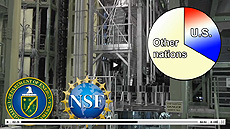 |
| Thousands of U.S. scientists participated in the discovery of the Higgs boson at the LHC, which was announced in July 2012. This year's Nobel Prize in physics was awarded to Francois Englert and Peter Higgs, who developed the theory of the mechanism that predicted the Higgs boson. This video describes the ways in which both the field of particle physics and the search for the Higgs boson is a global endeavor, one in which researchers from the United States play vital roles. View the video. Video: Fermilab |
|
U.S. scientists celebrate Nobel Prize for Higgs discovery
The Royal Swedish Academy of Sciences today awarded the Nobel Prize in physics to theorists Peter Higgs and Francois Englert to recognize their work developing the theory of what is now known as the Higgs field, which gives elementary particles mass. U.S. scientists played a significant role in advancing the theory and in discovering the particle that proves the existence of the Higgs field, the Higgs boson.
In the 1960s, Higgs and Englert, along with other theorists, including Robert Brout, Tom Kibble and Americans Carl Hagen and Gerald Guralnik, published papers introducing key concepts in the theory of the Higgs field. In 2012, scientists on the international ATLAS and CMS experiments, performed at the Large Hadron Collider at CERN laboratory in Europe, confirmed this theory when they announced the discovery of the Higgs boson.
Nearly 2,000 physicists from U.S. institutions — including 89 U.S. universities and seven U.S. Department of Energy laboratories — participate in the ATLAS and CMS experiments, making up about 23 percent of the ATLAS collaboration and 33 percent of CMS at the time of the Higgs discovery. Brookhaven National Laboratory serves as the U.S. hub for the ATLAS experiment, and Fermi National Accelerator Laboratory serves as the U.S. hub for the CMS experiment. U.S. scientists provided a significant portion of the intellectual leadership on Higgs analysis teams for both experiments.
Read more
|
Phase I of MicroBooNE installation at LArTF is almost complete
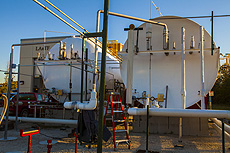 |
Exterior piping and control valve installation for Phase I of the MicroBooNE cryogenic system is essentially complete. Vacuum pumping and leak checking is under way. The liquid-argon dewar is on the right; the liquid-nitrogen dewar is on the left. Photo: Cindy Arnold
|
Phase I installation of the cryogenic system for the MicroBooNE experiment at the Liquid-Argon Test Facility is essentially complete.
Vacuum pump-down for leak testing of the refrigeration plant piping has been under way for several weeks and should be completed soon. The Phase I MicroBooNE small test cryostat will be installed where the taped hexagon is marked on the floor (bottom picture). Delivery of the test cryostat is expected by the end of October. Operation of the Phase I refrigeration plant will begin after inspections are performed and approvals given for the operation of both the refrigeration plant and the LArTF building oxygen deficiency hazard safety system.
High-voltage testing of samples of various components of MicroBooNE will be conducted inside the small test cryostat. The information gained from the high-voltage performance of the components tested in liquid argon will determine if the large MicroBooNE cryostat may be welded closed and brought to LArTF for installation.
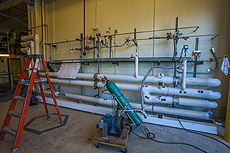 |
The MicroBooNE Phase I refrigeration plant piping in the LArTF loading dock area is being leak-checked. The MicroBooNE small test cryostat will be installed where the hexagon is marked by tape on the floor. Photo: Cindy Arnold
|
|
Higgs and Englert are awarded Nobel Prize in physics
From The New York Times, Oct. 8, 2013
Two theoretical physicists who suggested that an invisible ocean of energy suffusing space is responsible for the mass and diversity of the particles in the universe won the Nobel Prize in physics on Tuesday. They are Peter Higgs, 84, of the University of Edinburgh in Scotland, and François Englert, 80, of the University Libre de Bruxelles in Belgium.
Read more
|
|